Is An Oscilloscope Necessary For Servo Repair
Contributors: jimblom
Introduction
Have you ever found yourself troubleshooting a circuit, needing more data than a uncomplicated multimeter can provide? If you lot need to uncover information like frequency, noise, aamplitude, or any other characteristic that might change over time, you demand an oscilloscope!
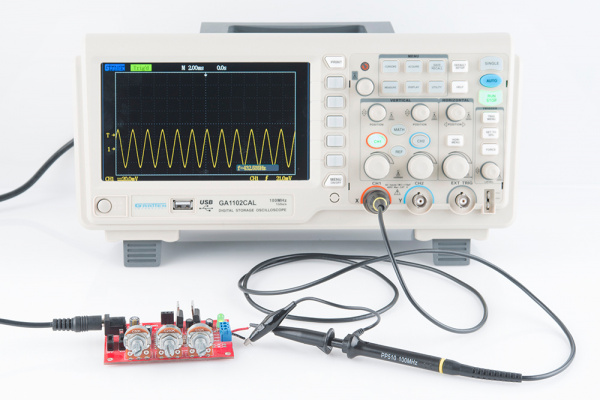
O-scopes are an important tool in any electric engineer's lab. They allow you to see electrical signals as they vary over fourth dimension, which can exist disquisitional in diagnosing why your 555 timer circuit isn't blinking correctly, or why your dissonance maker isn't reaching maximum annoyance levels.
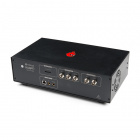
HAMlab - 160-6 10W
WRL-15001
HAMlab is a fully functional SDR transceiver with 160-10m band coverage and 10W of output power congenital around the STEMlab plat…
Covered in This Tutorial
This tutorial aims to innovate the concepts, terminology, and control systems of oscilloscopes. It's broken downward into the following sections:
- Basics of O-Scopes -- An introduction to what, exactly, oscilloscopes are, what they measure out, and why we use them.
- Oscilloscope Dictionary -- A glossary roofing some of the more than common oscilloscope characteristics.
- Beefcake of an O-Telescopic -- An overview of the virtually critical systems on an oscilloscope -- the screen, horizontal and vertical controls, triggers, and probes.
- Using an Oscilloscope -- Tips and tricks for someone using an oscilloscope for the first fourth dimension.
We'll exist using the Gratten GA1102CAL -- a handy, mid-level, digital oscilloscope -- equally the basis for our scope discussion. Other o-scopes may wait different, but they should all share a similar set up of control and interface mechanisms.
Suggested Reading
Before continuing with this tutorial, you should be familiar with the concepts beneath. Check out the tutorial if yous desire to acquire more!
- Voltage, Current, Resistance and Ohm's Law
- How to Utilise a Multimeter
- Analog vs. Digital
- Alternate Current (Ac) vs. Directly Current (DC)
Video
Basics of O-Scopes
The main purpose of an oscilloscope is to graph an electrical signal as it varies over time. Most scopes produce a two-dimensional graph with fourth dimension on the x-axis and voltage on the y-axis.

An example of an oscilloscope brandish. A betoken (the yellowish sine wave in this instance) is graphed on a horizontal time axis and a vertical voltage centrality.
Controls surrounding the scope's screen allow you to adjust the scale of the graph, both vertically and horizontally -- assuasive you to zoom in and out on a signal. There are likewise controls to set up the trigger on the scope, which helps focus and stabilize the display.
What Tin Scopes Measure
In improver to those key features, many scopes have measurement tools, which assist to quickly quantify frequency, aamplitude, and other waveform characteristics. In general a scope tin can measure both fourth dimension-based and voltage-based characteristics:
- Timing characteristics:
- Frequency and period -- Frequency is defined as the number of times per 2nd a waveform repeats. And the catamenia is the reciprocal of that (number of seconds each repeating waveform takes). The maximum frequency a scope can measure out varies, only it's often in the 100's of MHz (1E6 Hz) range.
- Duty cycle -- The percentage of a flow that a moving ridge is either positive or negative (at that place are both positive and negative duty cycles). The duty cycle is a ratio that tells y'all how long a point is "on" versus how long it's "off" each flow.
- Ascent and autumn time -- Signals can't instantaneously get from 0V to 5V, they have to smoothly rising. The elapsing of a wave going from a low point to a high indicate is called the ascension time, and autumn fourth dimension measures the opposite. These characteristics are of import when because how fast a circuit can respond to signals.
- Voltage characteristics:
- Aamplitude -- Amplitude is a measure of the magnitude of a signal. There are a variety of amplitude measurements including height-to-superlative amplitude, which measures the accented difference between a high and low voltage signal of a signal. Top amplitude, on the other hand, merely measures how high or low a signal is past 0V.
- Maximum and minimum voltages -- The scope can tell you exactly how high and depression the voltage of your signal gets.
- Mean and average voltages -- Oscilloscopes can calculate the average or hateful of your indicate, and it can also tell y'all the average of your point's minimum and maximum voltage.
When to Use an O-Scope
The o-telescopic is useful in a diverseness of troubleshooting and research situations, including:
- Determining the frequency and aamplitude of a signal, which tin can exist critical in debugging a circuit's input, output, or internal systems. From this, you can tell if a component in your circuit has malfunctioned.
- Identifying how much noise is in your circuit.
- Identifying the shape of a moving ridge -- sine, square, triangle, sawtooth, complex, etc.
- Quantifying phase differences betwixt 2 different signals.
Oscilloscope Lexicon
Learning how to utilize an oscilloscope ways being introduced to an entire lexicon of terms. On this page we'll introduce some of the important o-telescopic buzzwords yous should be familiar with before turning i on.
Key Oscilloscope Specifications
Some scopes are better than others. These characteristics assistance define how well y'all might expect a scope to perform:
- Bandwidth -- Oscilloscopes are nearly commonly used to mensurate waveforms which accept a defined frequency. No scope is perfect though: they all have limits as to how fast they can run across a signal modify. The bandwidth of a scope specifies the range of frequencies it can reliably mensurate.
- Digital vs. Analog -- Every bit with most everything electronic, o-scopes tin either be analog or digital. Analog scopes use an electron beam to directly map the input voltage to a display. Digital scopes comprise microcontrollers, which sample the input signal with an analog-to-digital converter and map that reading to the display. More often than not analog scopes are older, have a lower bandwidth, and less features, but they may have a faster response (and look much cooler).
- Aqueduct Amount -- Many scopes tin can read more than than one point at a time, displaying them all on the screen simultaneously. Each bespeak read by a scope is fed into a separate channel. Two to four channel scopes are very common.
- Sampling Rate -- This characteristic is unique to digital scopes, it defines how many times per second a point is read. For scopes that have more than than one aqueduct, this value may subtract if multiple channels are in use.
- Rising Time -- The specified ascension fourth dimension of a scope defines the fastest ascension pulse it tin measure. The rise time of a scope is very closely related to the bandwidth. Information technology can be calculated as
Rise Time=0.35/Bandwidth. - Maximum Input Voltage -- Every piece of electronics has its limits when it comes to high voltage. Scopes should all be rated with a maximum input voltage. If your betoken exceeds that voltage, there's a good adventure the scope will exist damaged.
- Resolution -- The resolution of a telescopic represents how precisely information technology can measure the input voltage. This value can change as the vertical scale is adjusted.
- Vertical Sensitivity -- This value represents the minimum and maximum values of your vertical, voltage scale. This value is listed in volts per div.
- Time Base -- Time base ordinarily indicates the range of sensitivities on the horizontal, time axis. This value is listed in seconds per div.
- Input Impedance -- When signal frequencies get very loftier, even a small impedance (resistance, capacitance, or inductance) added to a circuit can affect the signal. Every oscilloscope will add a certain impedance to a excursion it's reading, called the input impedance. Input impedances are by and large represented equally a large resistive impedance (>1 MΩ) in parallel (||) with small capacitance (in the pF range). The touch of input impedance is more apparent when measuring very high frequency signals, and the probe you utilize may have to assist compensate for it.
Using the GA1102CAL every bit an example, hither are specifications you might await from a mid-range scope:
| Characteristic | Value |
|---|---|
| Bandwidth | 100 MHz |
| Sampling Rate | 1 GSa/due south (1E9 samples per second) |
| Rise Time | <iii.5ns |
| Channel Count | two |
| Maximum Input Voltage | 400V |
| Resolution | 8-chip |
| Vertical sensitivity | 2mV/div - 5V/div |
| Time base | 2ns/div - 50s/div |
| Input Impedance | 1 MΩ ±iii% || 16pF ±3pF |
Understanding these characteristics, you should be able to pick out an oscilloscope that'll best fit your needs. But you lot still have to know how to use it...onto the next folio!
Anatomy of An O-Scope
While no scopes are created exactly equal, they should all share a few similarities that make them role similarly. On this page we'll talk over a few of the more common systems of an oscilloscope: the display, horizontal, vertical, trigger, and inputs.
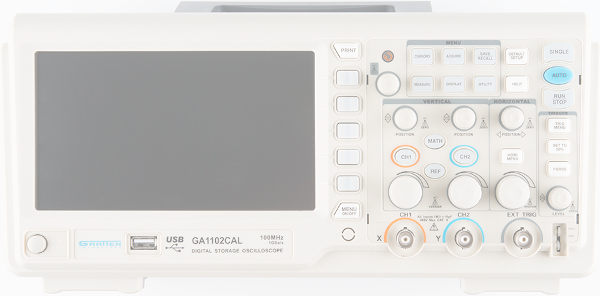
The Display
An oscilloscope isn't any adept unless it tin can display the data you're trying to test, which makes the display one of the more than important sections on the telescopic.

Every oscilloscope display should exist criss-crossed with horizontal and vertical lines called divisions. The scale of those divisions are modified with the horizontal and vertical systems. The vertical system is measured in "volts per partition" and the horizontal is "seconds per division". Generally, scopes will feature around viii-10 vertical (voltage) divisions, and 10-14 horizontal (seconds) divisions.
Older scopes (especially those of the analog diverseness) ordinarily feature a unproblematic, monochrome brandish, though the intensity of the wave may vary. More than modern scopes characteristic multicolor LCD screens, which are a great aid in showing more than than one waveform at a time.
Many telescopic displays are situated next to a set of about five buttons -- either to the side or below the brandish. These buttons can be used to navigate menus and control settings of the telescopic.
Vertical System
The vertical section of the scope controls the voltage scale on the display. There are traditionally two knobs in this section, which permit you to individually control the vertical position and volts/div.

The more critical volts per division knob allows you to set the vertical scale on the screen. Rotating the knob clockwise will subtract the scale, and counter-clockwise will increase. A smaller calibration – fewer volts per sectionalization on the screen – means you're more "zoomed in" to the waveform.
The display on the GA1102, for example, has 8 vertical divisions, and the volts/div knob can select a scale between 2mV/div and 5V/div. So, zoomed all the way in to 2mV/div, the brandish tin show waveform that is 16mV from superlative to lesser. Fully "zoomed out", the scope can show a waveform ranging over 40V. (The probe, equally we'll discuss below, can farther increase this range.)
The position knob controls the vertical offset of the waveform on the screen. Rotate the knob clockwise, and the moving ridge will movement down, counter-clockwise will move it upwards the brandish. Yous can utilise the position knob to first role of a waveform off the screen.
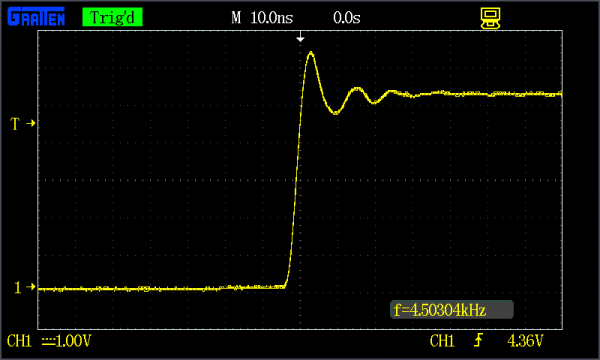
Using both the position and volts/div knobs in conjunction, you can zoom in on just a tiny function of the waveform that you lot intendance about the most. If you had a 5V foursquare wave, merely only cared about how much information technology was ringing on the edges, you lot could zoom in on the rising edge using both knobs.
Horizontal System
The horizontal section of the scope controls the fourth dimension calibration on the screen. Like the vertical arrangement, the horizontal control gives you 2 knobs: position and seconds/div.
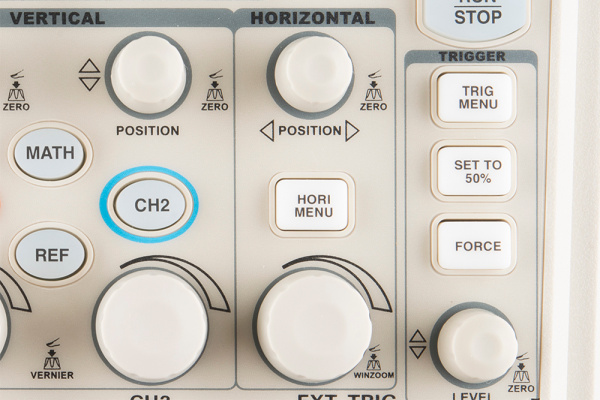
The seconds per division (s/div) knob rotates to increase or decrease the horizontal calibration. If you rotate the s/div knob clockwise, the number of seconds each division represents will decrease – you'll be "zooming in" on the time scale. Rotate counter-clockwise to increase the time scale, and show a longer amount of time on the screen.
Using the GA1102 equally an example once again, the brandish has xiv horizontal divisions, and can prove anywhere betwixt 2nS and 50s per division. So zoomed all the fashion in on the horizontal scale, the telescopic can show 28nS of a waveform, and zoomed way out information technology can show a signal as information technology changes over 700 seconds.
The position knob can move your waveform to the right or left of the brandish, adjusting the horizontal outset.
Using the horizontal organization, you can accommodate how many periods of a waveform you want to see. Yous tin zoom out, and show multiple peaks and troughs of a signal:
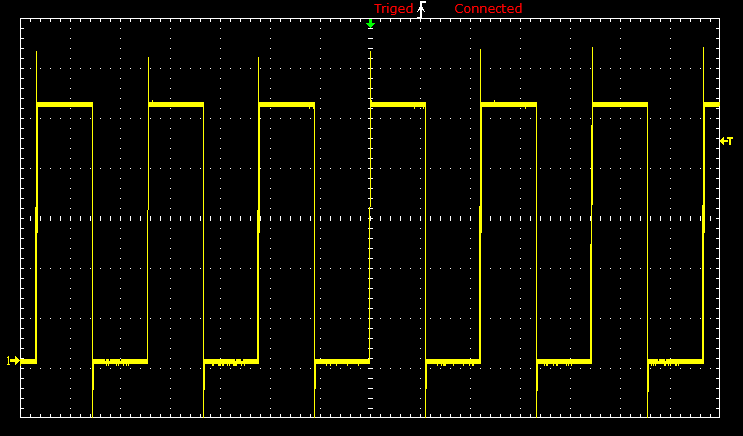
Or y'all can zoom mode in, and utilize the position knob to show just a tiny function of a wave:

Trigger System
The trigger section is devoted to stabilizing and focusing the oscilloscope. The trigger tells the scope what parts of the signal to "trigger" on and commencement measuring. If your waveform is periodic, the trigger tin can exist manipulated to keep the brandish static and unflinching. A poorly triggered moving ridge volition produce seizure-inducing sweeping waves like this:

The trigger department of a scope is usually comprised of a level knob and a fix of buttons to select the source and type of the trigger. The level knob can be twisted to set a trigger to a specific voltage indicate.
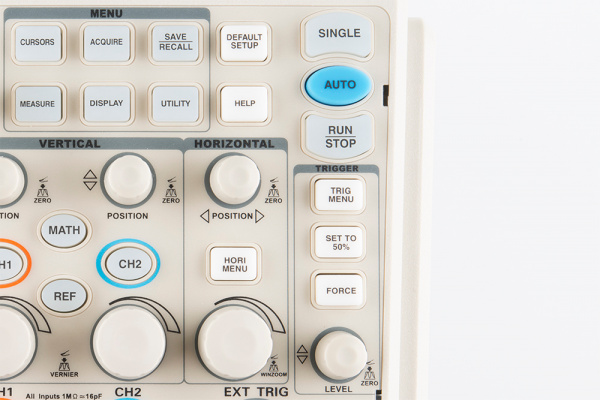
A series of buttons and screen menus make up the rest of the trigger system. Their main purpose is to select the trigger source and mode. There are a variety of trigger types, which dispense how the trigger is activated:
- An edge trigger is the nearly bones course of the trigger. It volition key the oscilloscope to start measuring when the signal voltage passes a certain level. An border trigger can be fix to take hold of on a ascension or falling edge (or both).
- A pulse trigger tells the scope to central in on a specified "pulse" of voltage. You can specify the elapsing and direction of the pulse. For example, it can be a tiny blip of 0V -> 5V -> 0V, or it tin be a seconds-long dip from 5V to 0V, dorsum to 5V.
- A slope trigger tin can be set to trigger the scope on a positive or negative gradient over a specified amount of fourth dimension.
- More complicated triggers exist to focus on standardized waveforms that carry video data, like NTSC or PAL. These waves apply a unique synchronizing pattern at the start of every frame.
Yous can likewise usually select a triggering mode, which, in effect, tells the telescopic how strongly y'all feel well-nigh your trigger. In automated trigger mode, the scope can attempt to draw your waveform fifty-fifty if it doesn't trigger. Normal mode volition but draw your wave if it sees the specified trigger. And unmarried mode looks for your specified trigger, when it sees it it will describe your wave so stop.
The Probes
An oscilloscope is but good if yous can actually connect it to a signal, and for that you need probes. Probes are single-input devices that route a signal from your excursion to the scope. They take a sharp tip which probes into a point on your circuit. The tip can also be equipped with hooks, tweezers or clips to make latching onto a circuit easier. Every probe too includes a footing prune, which should be secured safely to a common ground point on the circuit under test.
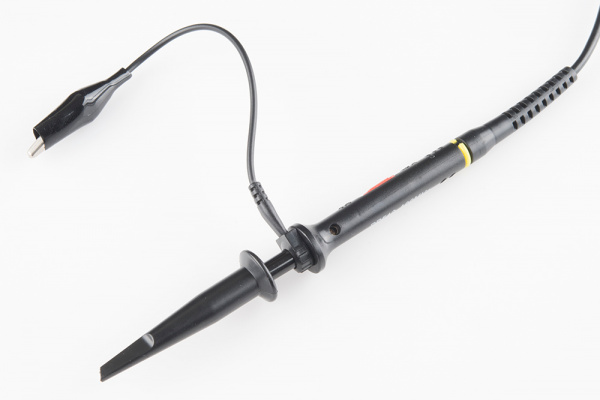
While probes may seem like simple devices that but latch onto your circuit and acquit a signal to the scope, there'southward really a lot that goes into probe design and selection.
Optimally, what a probe needs to be is invisible – it shouldn't take whatever issue on your betoken under test. Unfortunately, long wires all have intrinsic inductance, capacitance, and resistance, and so, no thing what, they'll affect scope readings (peculiarly at high frequencies).
There are a diversity of probe types out there, the most mutual of which is the passive probe, included with most scopes. Most of the "stock" passive probes are attenuated. Attenuating probes have a big resistance intentionally born and shunted by a small capacitor, which helps to minimize the upshot that a long cable might take on loading your circuit. In serial with the input impedance of a scope, this attenuated probe volition create a voltage divider between your signal and the scope input.
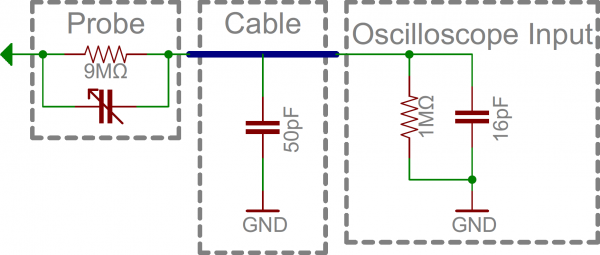
Nigh probes have a 9MΩ resistor for attenuating, which, when combined with a standard 1MΩ input impedance on a scope, creates a 1/x voltage divider. These probes are commonly called 10X attenuated probes. Many probes include a switch to select between 10X and 1X (no attenuation).
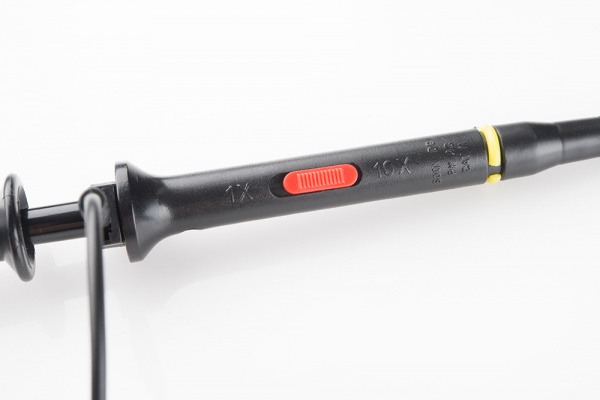
Attenuated probes are great for improving accuracy at high frequencies, merely they volition also reduce the amplitude of your signal. If yous're trying to measure a very low-voltage signal, you lot may have to go with a 1X probe. You may likewise demand to select a setting on your scope to tell it you're using an attenuated probe, although many scopes tin automatically find this.
Beyond the passive adulterate probe, there are a variety of other probes out at that place. Active probes are powered probes (they crave a separate power source), which tin can amplify your point or even pre-procedure it before it get to your telescopic. While most probes are designed to mensurate voltage, there are probes designed to measure AC or DC current. Current probes are unique because they ofttimes clench around a wire, never really making contact with the circuit.
Using an Oscilloscope
The infinite diversity of signals out there means y'all'll never operate an oscilloscope the same way twice. Only there are some steps you tin count on performing just about every fourth dimension yous test a excursion. On this page we'll show an example signal, and the steps required to measure it.
Probe Selection and Setup
First off, yous'll need to select a probe. For nearly signals, the elementary passive probe included with your scope volition work perfectly fine.
Side by side, before connecting information technology to your scope, set the attenuation on your probe. 10X -- the most common attenuation factor -- is commonly the nearly well-rounded option. If you're trying to measure a very depression-voltage signal though, you may need to employ 1X.
Connect the Probe and Plow the Scope On
Connect your probe to the first channel on your telescopic, and turn it on. Accept some patience hither, some scopes take as long to boot up as an sometime PC.
When the telescopic boots up you lot should see the divisions, scale, and a noisy, flat line of a waveform.

The screen should as well show previously prepare values for time and volts per div. Ignoring those scales for now, make these adjustments to put your scope into a standard setup:
- Turn aqueduct 1 on and channel 2 off.
- Gear up channel 1 to DC coupling.
- Fix the trigger source to channel 1 -- no external source or alternate channel triggering.
- Gear up the trigger type to rising edge, and the trigger mode to auto (as opposed to unmarried).
- Make sure the scope probe attenuation on your scope matches the setting on your probe (due east.g. 1X, 10X).
For help making these adjustments, consult your telescopic'south user's manual (equally an example, here's the GA1102CAL manual).
Testing the Probe
Allow's connect that channel up to a meaningful bespeak. Almost scopes will accept a built-in frequency generator that emits a reliable, ready-frequency moving ridge -- on the GA1102CAL there is a 1kHz square moving ridge output at the bottom-right of the front console. The frequency generator output has two separate conductors -- one for the signal and one for footing. Connect your probe's ground clip to the ground, and the probe tip to the signal output.
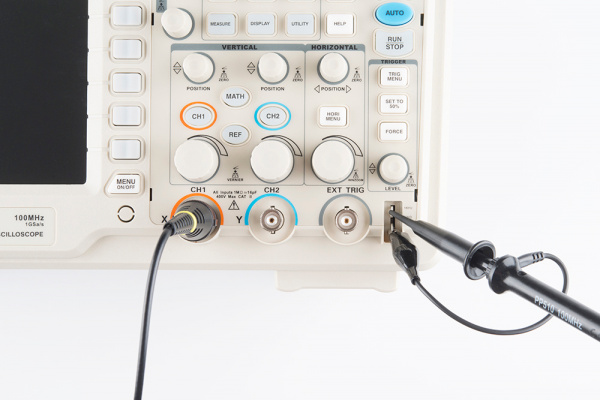
As soon as you connect both parts of the probe, yous should meet a bespeak begin to dance around your screen. Try lilliputian with the horizontal and vertical system knobs to maneuver the waveform around the screen. Rotating the scale knobs clockwise will "zoom into" your waveform, and counter-clockwise zooms out. Yous can besides use the position knob to further locate your waveform.
If your wave is still unstable, try rotating the trigger position knob. Make sure the trigger isn't college than the tallest superlative of your waveform. By default, the trigger type should be set to border, which is normally a good choice for foursquare waves like this.
Try fiddling with those knobs plenty to display a single period of your wave on the screen.
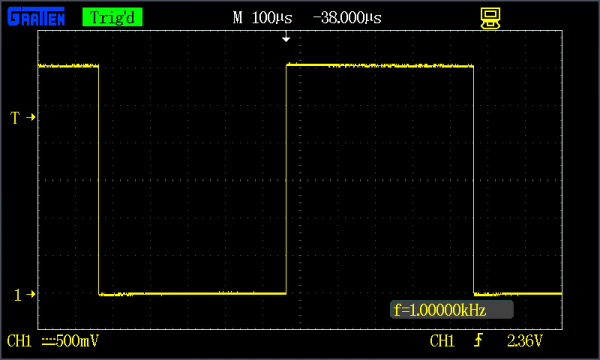
Or endeavour zooming way out on the time scale to show dozens of squares.
Compensating an Attenuated Probe
If your probe is set to 10X, and yous don't have a perfectly foursquare waveform every bit shown to a higher place, yous may demand to compensate your probe. Nigh probes have a recessed screw caput, which you can rotate to adjust the shunt capacitance of the probe.
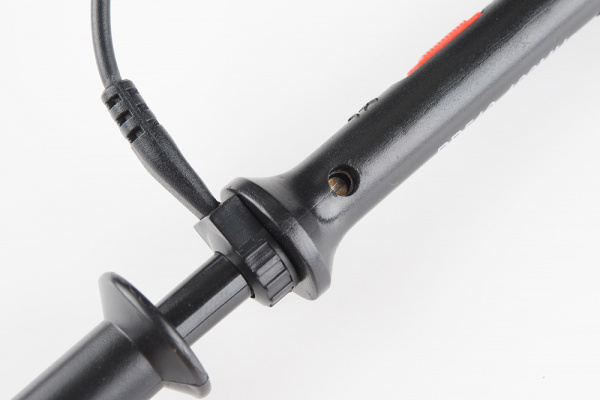
Attempt using a small-scale screwdriver to rotate this trimmer, and wait at what happens to the waveform.
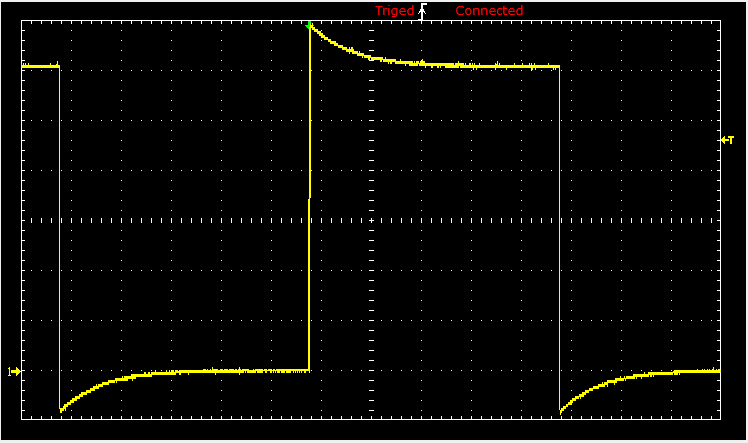
Suit the trimming cap on the probe handle until y'all have a straight-edged square wave. Compensation is only necessary if your probe is adulterate (eastward.thousand. 10X), in which case it'southward critical (especially if you don't know who used your telescopic concluding!).
Probing, Triggering, and Scaling Tips
Once you've compensated your probe, it's fourth dimension to measure a existent betoken! Go find a signal source (frequency generator?, Terror-Min?) and come dorsum.
The first cardinal to probing a indicate is finding a solid, reliable grounding bespeak. Squeeze your ground clip to a known footing, sometimes y'all may have to use a small wire to intermediate between the ground clip and your excursion's basis point. And so connect your probe tip to the bespeak nether examination. Probe tips exist in a variety of course factors -- the jump-loaded clip, fine point, hooks, etc. -- attempt to find one that doesn't require you to concord information technology in identify all the time.
⚡ Heads upwards! Be careful where you place your footing clip when probing a not-isolated excursion (eg. non battery powered or using an isolated power supply). When probing a excursion that is grounded to mains globe, make sure to connect your ground clip to the side of the excursion connected to mains earth. This is almost e'er the negative/footing side of the circuit but tin sometimes be another betoken. If the point the ground clip is connected to has a potential voltage departure you lot will create a direct short and can damage your circuit, your oscilloscope and possibly yourself! For actress safety when testing mains connected circuits, connect it to ability through an isolation transformer.

In one case your signal is on the screen, you may want to begin by adjusting the horizontal and vertical scales into at least the "ballpark" of your signal. If yous're probing a 5V 1kHz square wave, you'll probably want the volts/div somewhere around 0.5-1V, and set the seconds/div to around 100µs (14 divisions would evidence about i and a half periods).
If part of your moving ridge is rising or falling of the screen, yous can adjust the vertical position to move it up or down. If your signal is purely DC, you lot may desire to suit the 0V level virtually the bottom of your display.
In one case you have the scales ballparked, your waveform may need some triggering. Border triggering -- where the scope tries to begin its browse when it sees voltage rise (or fall) past a set point -- is the easiest type to apply. Using an edge trigger, try to set the trigger level to a indicate on your waveform that only sees a rising border once per period.
Now just scale, position, trigger and repeat until you're looking at exactly what you lot demand.
Measure Twice, Cut One time
With a signal scoped, triggered, and scaled, information technology comes fourth dimension to measure transients, periods, and other waveform properties. Some scopes take more than measurement tools than others, merely they'll all at least have divisions, from which you should be able to at to the lowest degree guess the amplitude and frequency.
Many scopes support a variety of automatic measurement tools, they may even constantly brandish the virtually relevant information, like frequency. To go the virtually out of your scope, y'all'll want to explore all of the measure out functions it supports. Well-nigh scopes will calculate frequency, amplitude, duty cycle, mean voltage, and a variety of other wave characteristics for yous automatically.

Using the telescopic's measure tools to discover VPP, 5Max, frequency, menstruum, and duty cycle.
A third measuring tool many scopes provide is cursors. Cursors are on-screen, movable markers which can exist placed on either the time or voltage axis. Cursors usually come in pairs, so you lot can measure the divergence between i and the other.
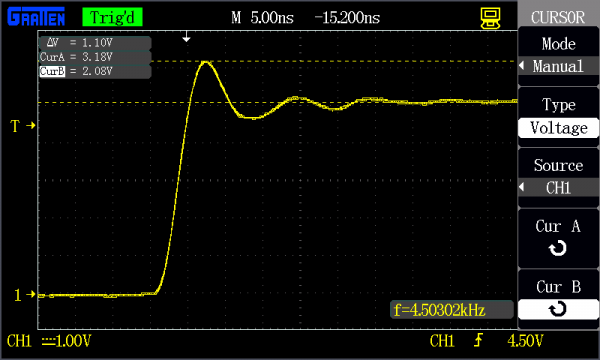
Measuring the ringing of a square wave with cursors.
Once y'all've measured the quantity you lot were looking for, you tin begin to make adjustments to your circuit and measure some more than! Some scopes as well support saving, printing, or storing a waveform, so yous tin can recall it and remember those good ol' times when you scoped that signal.
To find out more than about what your scope tin do, consult its user's manual!
Purchasing an Oscilloscope
Now that y'all've learned all almost this handy tool'southward features and benefits, it'south time to put an oscilloscope on your workbench.
Our recommendations:
View all options
Resources and Going Further
With the tools discussed in this tutorial, you should be prepared to start scoping signals of your own. If you're nonetheless unsure of what certain parts of your scope are for, offset consult your user's transmission. Here are some additional resource we recommend checking out as well:
- The XYZs of Oscilloscopes (PDF) -- A nifty in-depth introduction to oscilloscopes.
- How to Employ an Oscilloscope (YouTube) -- Neat o-scope explanation directly from the makers of scopes (Tektronix).
- GA1102CAL User'south Manual -- A user'south manual for Atten'southward GA1102CAL 100MHz oscilloscope. While information technology's specific to that scope, information technology nonetheless provides a prissy overview of what similar scopes are capable of, and how they piece of work.
Going Further
At present that you're a skilful oscilloscop-er, what excursion are you going to be debugging? Need some inspiration? Here are some related tutorials nosotros'd recommend checking out next!
- PCB Blueprint with EAGLE -- If you're at a point where y'all demand to troubleshoot circuits at the signal level, maybe you're set up to step into designing PCBs. Our Hawkeye series of tutorials how to use the freely available software to design your own circuit boards.
- Recreating Classic Electronics Kits -- If you lot're in search of a excursion to troubleshoot with a scope, why not make your ain version of 50-in-1 electronics kit?
- Pulse-Width Modulation -- PWM signals are the foundation behind dimming LEDs and driving servo motors. Learn about these signal types and and then telescopic them with your new skills!
Or check out these tutorials using an oscilloscope to audit a signal.
MCP4725 Digital to Analog Converter Hookup Guide
This is a quick hookup to help you get started with the MCP4725 DAC breakout lath. This device allows you to send analog signal from a digital source, like the I2C interface on the Arduino microcontroller.
Boss Alarm
Build a Boss Alarm that alerts you of anyone walking into your office and automatically changes your calculator screen.
SparkFun Clock Generator 5P49V60 (Qwiic) Hookup Guide
The SparkFun Clock Generator 5P49V60 (Qwiic) breakout board offers a wide range of customizable frequencies in a wide range of unlike betoken types using a single reference clock. This hookup guide will go over all of the many bachelor functions and gives the hardware rundown on what exactly is on this board.
Or cheque out this blog postal service for ideas.
Source: https://learn.sparkfun.com/tutorials/how-to-use-an-oscilloscope/all
Posted by: marlermuscom1994.blogspot.com



0 Response to "Is An Oscilloscope Necessary For Servo Repair"
Post a Comment